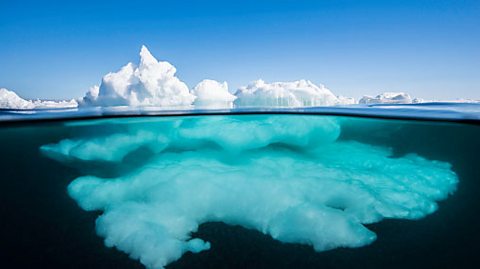Key points
Substances can exist in three states of matter - solid, liquid and gas.
All substances are made from particles, and the forces between the particles are different in solids, liquids and gases.
The arrangement, movement and spacing of the particles explain many of the properties of solids, liquids and gases.
Video
Watch this video to see a model of how particleA single piece of matter from an element or a compound, which is too small to be seen. Particles can be atoms, molecules or ions. are arranged in solids, liquids and gases.
Solids, liquids and gases. In a solid like this brick, the particles are regularly arranged touching their neighbours and move only by vibrating. This explains why solids have a fixed shape.
In a liquid like water, the particles are randomly arranged. They move freely over each other, a bit like marbles in a bucket.This is why liquids can be poured.
In a gas, like helium, particles are widely spaced apart and move quickly and random directions. They have no fixed volume and fill the space of their container. They travel in straight lines until they hit something, like the walls of the container they're in, or each other.
Describe the arrangement and movement of the particles in a solid, liquid and gas.
In a solid, the particles pack together tightly in a neat and ordered arrangement. The particles are held together too strongly to allow much movement but the particles do vibrate.
In liquids, particles are quite close together and move with random motion throughout the container.
In gases the particles move rapidly in all directions, frequently colliding with each other and the side of the container.
Solids
Lots of materials are solid, such as paper, bricks, wood, metal and ice.
There are strong forces between the particlesAll substances are made of particles. Particles could be atoms, molecules or ions. in a solid which hold the particles in fixed positions, in a regular arrangement. The particles are close together and vibrate about these fixed positions. They cannot move from place to place.
Because the particles are in fixed positions, solids have a fixed shape and cannot flow like liquidOne of the three states of matter. Liquids, like water or oil, do not have a fixed shape and can flow. or gasOne of the three states of matter. Gases, like oxygen or helium, do not have a fixed shape and can expand to fill their container.. There is very little space between the particles in solids, so they cannot usually be compressedAnother word for squashed. Solids and liquids cannot be easily compressed, but gases can..
When drawing the particles in a solid, they should be closely spaced, in neat, ordered rows.
Liquids
Examples of common liquids include water, oil and fruit juice.
The forceA force is a push or a pull that acts on an object due to the interaction with another object. between the particlesAll substances are made of particles. Particles could be atoms, molecules or ions. in a liquidOne of the three states of matter. Liquids, like water or oil, do not have a fixed shape and can flow. are weaker than the forces between particles in a solidOne of the three states of matter. Solids, like ice or concrete, have a fixed shape and cannot be compressed easily., so the particles are not held in fixed positions.
The particles in a liquid are still close together, like the particles in a solid, but are arranged randomly. As well as vibrating, the particles in a liquid can move from place to place.
Because the particles are not in fixed positions and can move about and vibrate, liquids do not have a fixed shape and can flow. This means that a liquid will take the shape of the bottom of its container. Like a solid, there is very little space between the particles in liquids, so they cannot usually be compressedAnother word for squashed. Solids and liquids cannot be easily compressed, but gases can..
When drawing the particles in a liquid, they should be closely spaced with very few gaps, in a random arrangement.
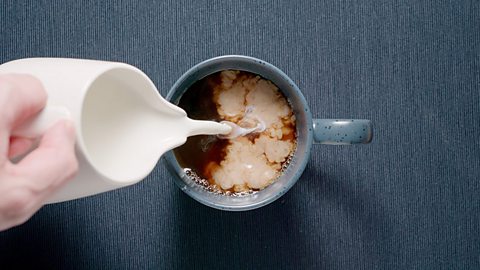
Liquids and gases are both examples of fluidSubstances that can flow and change shape easily, like water. Liquids and gases are both examples of fluids.. They can both flow, and some gases can even be poured, like a liquid.

Gases
There are lots of different gasOne of the three states of matter. Gases, like oxygen or helium, do not have a fixed shape and can expand to fill their container. including:
the air we breathe
the steam produced when a kettle boils
the helium used to fill balloons.
The particlesAll substances are made of particles. Particles could be atoms, molecules or ions. in a gas have enough energyEnergy can be stored and transferred. Energy is a conserved quantity. to overcome the attractive forceA force is a push or a pull that acts on an object due to the interaction with another object. that try to hold them together. Because of this, the particles in a gas are widely spaced and free to move in any direction. The particles in a gas do not vibrate - instead they move quickly in straight lines, in random directions. This means the particles can collide with each other and with the walls of any container present.
Because the particles in a gas can move freely in all directions, gases do not have a fixed shape. They can expand to fill their container and flow to take its shape. Gases can also be compressedAnother word for squashed. Solids and liquids cannot be easily compressed, but gases can. easily because there is lots of space between the particles.
When drawing the particles in a gas, they should be widely spaced and in a random arrangement
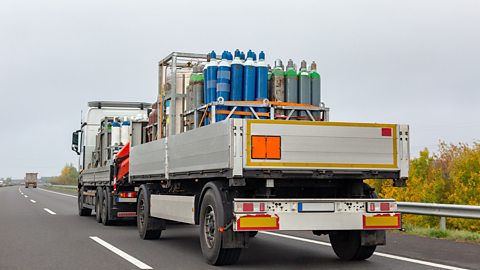
If a gas is compressed to a very high pressure, it can become a liquidOne of the three states of matter. Liquids, like water or oil, do not have a fixed shape and can flow..
Gases are often compressed before being transported, so they take up less space.

Test your knowledge
Quiz
GCSE exam dates 2025
Find out everything you need to know about the 2025 GCSE exams including dates, timetables and changes to exams to get your revision in shape.

More on Solids, liquids and gases
Find out more by working through a topic
- count2 of 4
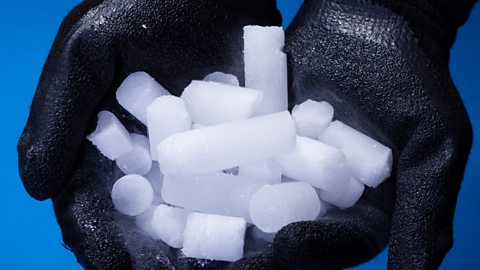
- count3 of 4
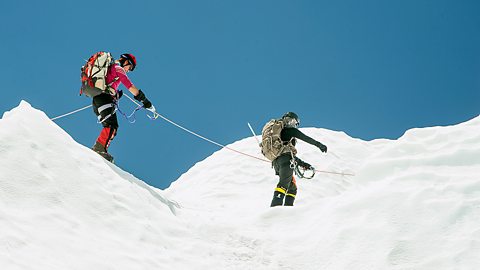
- count4 of 4
